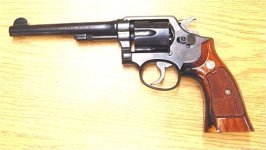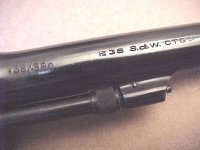This looks just like my brother's six-inch .38/200, except that his had the original grips. Probably shipped in 1940 or 1941.
If the serial No. is "off" for the date, that sort of thing happens with S&W. Check out the S&W collectors' board at
www.smith-wessonforum.com . They sometimes discuss this stuff.
One explanation could be that the frame had been made and numbered, but not made up into a complete gun until the British order came in. Or the gun may have been sold commercially in Britain well before the war, not being part of the military orders beginning in April, 1940. However, it has the Broad Arrow acceptance marks, so I'd think it was a military order.
Looks like a nice, clean piece. Take care of it. Should be good for rabbits or most snakes out to maybe 25 yards. This is an interesting piece of history.
By the way, I saw a photo of RAF pilots in North Africa with the butts of their revolvers hanging way out of their canvas webbing holsters, which were made for five-inch barrelled guns. I think what happened was that they had these six-inch barrels, and were using available holsters. Wouldn't be surprised if some were issued with holsters for the Webley Mk. VI .455, which were probably long enough to fit, although the guns probably moved around inside as the wearer ran or jumped. As far as I know, no special holsters were issued for these longer barrels, although local armorers may have improvised something. I read somewhere that the four-inch model was popular with Field Security troops, who sometimes carried their revolvers in their coats.
Lone Star



